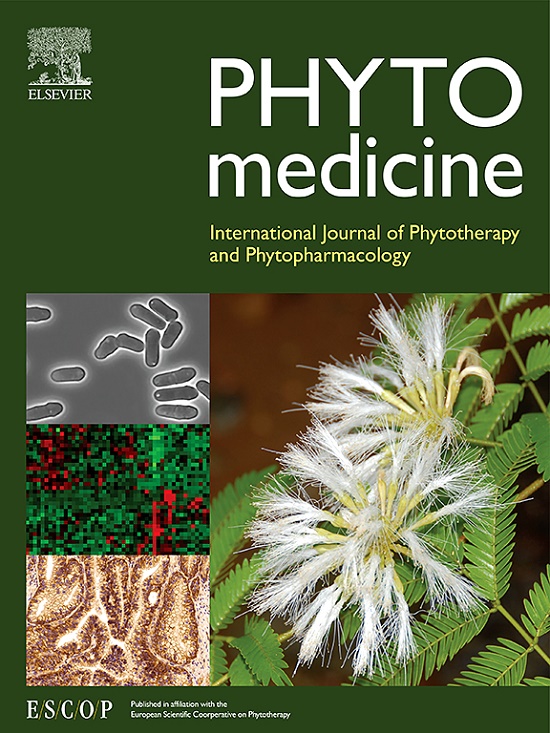综合代谢组学和网络药理学揭示射香保心丸抗动脉粥样硬化的机制
IF 6.7
1区 医学
Q1 CHEMISTRY, MEDICINAL
引用次数: 0
摘要
背景动脉粥样硬化是一种以血管内皮发生脂质病变为特征的疾病,仍然是导致全球死亡的一个主要因素。射香保心丸(SBP)已被用于治疗多种心血管疾病,但其复杂的作用机制仍不清楚。本研究旨在确定射香保心丸对动脉粥样硬化的潜在影响及其潜在的调控机制。方法利用网络药理学预测关键的药物-疾病靶点,并应用非靶点代谢组学检测确定关键代谢物和代谢途径。结果表明,SBP 在体内可通过降低血脂水平、斑块形成和内皮损伤发挥保护作用。网络药理学和代谢组学显示,MAPK3、AKT1 和 STAT3 是中心靶点,三甲胺正氧化物(TMAO)是关键代谢物。由于 TMAO 具有致动脉粥样硬化的作用,因此研究人员在体外研究了 SBP 的相应保护作用。SBP 可抑制 TMAO 诱导的内皮细胞凋亡和氧化应激,并抵消 MAPK3、AKT1 和 STAT3 表达的上调。综合来看,基于代谢组学和网络药理学的研究结果表明,SBP 可能通过影响内皮功能和胆汁酸合成而与 TMAO 诱导的动脉粥样硬化有关。我们观察到,SBP 可通过多种途径调节 TMAO 水平,从而改善动脉粥样硬化,这可能为 SBP 通过介导肠道-心脏轴参与心血管保护提供了新的方向和见解。本文章由计算机程序翻译,如有差异,请以英文原文为准。
Integrated metabolomics and network pharmacology to reveal the mechanisms of Shexiang Baoxin pill against atherosclerosis
Background
Atherosclerosis is a disease marked by the development of lipid lesions within the endothelium and continues to be a prominent contributor to global mortality. Shexiang Baoxin pill (SBP) has been employed in the management of numerous cardiovascular diseases, but the complex mechanisms by which it operates remain obscure. This research was conducted to determine the potential impact of SBP on atherosclerosis and the underlying regulatory mechanism involved.
Method
Network pharmacology was utilized to predict the key drug-disease targets, and a nontargeted metabolomic assay was applied to identify the key metabolites and metabolic pathways. A mouse atherosclerosis model was constructed to clarify the protective effect of SBP on atherosclerosis, and in vivo and in vitro tests were performed to verify the analysis results and clarify the mechanism through which SBP affects atherosclerosis.
Results
The results show that SBP can exert a protective effect in vivo by decreasing lipid levels, plaque formation and endothelial damage. Network pharmacology and metabolomics revealed that MAPK3, AKT1 and STAT3 were the hub targets and that trimethylamine n-oxide (TMAO) was the pivotal metabolite. Due to the atherogenic effect of TMAO, the corresponding protective effect of SBP was investigated in vitro. SBP inhibited TMAO-induced endothelial cell apoptosis and oxidative stress and counteracted the upregulation of MAPK3, AKT1, and STAT3 expression. Molecular docking and enzymatic inhibition suggested that the active components of SBP could bind stably to key target proteins.
Conclusion
Taken together, based on the integrated metabolomics and network pharmacology, our findings suggest that SBP may be implicated in TMAO-induced atherosclerosis by affecting endothelial function and bile acid synthesis. We observed that SBP may ameliorate atherosclerosis by regulating TMAO levels through multiple pathways, which may provide a novel direction and insight for SBP involved in cardiovascular protection by mediating the gut-heart axis.
求助全文
通过发布文献求助,成功后即可免费获取论文全文。
去求助
来源期刊

Phytomedicine
医学-药学
CiteScore
10.30
自引率
5.10%
发文量
670
审稿时长
91 days
期刊介绍:
Phytomedicine is a therapy-oriented journal that publishes innovative studies on the efficacy, safety, quality, and mechanisms of action of specified plant extracts, phytopharmaceuticals, and their isolated constituents. This includes clinical, pharmacological, pharmacokinetic, and toxicological studies of herbal medicinal products, preparations, and purified compounds with defined and consistent quality, ensuring reproducible pharmacological activity. Founded in 1994, Phytomedicine aims to focus and stimulate research in this field and establish internationally accepted scientific standards for pharmacological studies, proof of clinical efficacy, and safety of phytomedicines.
 求助内容:
求助内容: 应助结果提醒方式:
应助结果提醒方式:


